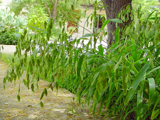Native Plants

Q. Who is Mr. Smarty Plants?
A: There are those who suspect Wildflower Center volunteers are the culpable and capable culprits. Yet, others think staff members play some, albeit small, role. You can torture us with your plant questions, but we will never reveal the Green Guru's secret identity.
Did you know you can access the Native Plant Information Network with your web-enabled smartphone?
Ask Mr. Smarty Plants is a free service provided by the staff and volunteers at the Lady Bird Johnson Wildflower Center.

rate this answer
Saturday - April 02, 2011
From: Newtown Square, PA
Region: Mid-Atlantic
Topic: Water Gardens
Title: Plant to stabilize a stream bank in PA
Answered by: Anne Bossart
QUESTION:
Native plants to stabilize steep stream bank in semi shade to full shade. Southeastern PA. ThanksANSWER:
As you embark on this project you will find this publication from the USDA National Agroforestry Center, Biotechnical Streambank Protection: The use of plants to stabilize streambanks (Agroforestry Note #23, March 2002) a very valuable resource.
Grasses are ideal for the task as they have fibrous root systems which hold the soil well. Some will grow right up to the water's edge, others will have to be placed further up the slope. There are also some shrubs, especially willows and dogwoods that can grow in the water at the edge of the stream.
Here are some suggestions; follow the links to detailed information pages to see their exact water and light requirements.
Andropogon glomeratus (Bushy bluestem) grows well in wet areas and prefers full sun. Andropogon virginicus (Broomsedge bluestem) is recommended for erosion control and grows in part shade. Carex blanda (Eastern woodland sedge) grows in moist soils in sun, part shade or shade. Chasmanthium latifolium (Inland sea oats) prefers shade or part shade and moist soils. Panicum virgatum (Switchgrass) grows along streambanks in sun or part shade. Tripsacum dactyloides (Eastern gamagrass) likes part shade and grows in moist areas or along streambanks. Cephalanthus occidentalis (Common buttonbush) grows in moist areas and will grow in standing water in shade or part shade. Salix humilis (Prairie willow) grows in sun along streambanks. Salix nigra (Black willow) grows in sun, part shade and shade along streambanks.
Sambucus nigra ssp. canadensis (Common elderberry) grows in part shade and is good for erosion control in moist areas. Alnus serrulata (Hazel alder) grows in sun, part shade and shade on stream banks and other wet areas. Spiraea alba (White meadowsweet) grows in sun, part shade and shade in swamps, wet meadows and shorelines. Cornus racemosa (Gray dogwood) grows in sun, part shade or shade in thickets, river bank woods; wet to dry, low, open areas Cornus sericea (Redosier dogwood) grows in part shade on river banks, lake shores in wooded or open, wet areas. Here are some photos from our Image gallery:
More Water Gardens Questions
Plants for area around a fountain in full sun near Dallas
May 19, 2010 - I'm seeking advice on what I can plant around the base of a fountain, in full sun, that can tolerate the fountain water splash/spray.
I'm seeking something that can be maintained to a maximum h...
view the full question and answer
Landscaping with water garden from Pendleton SC
August 15, 2012 - Searching for native plants in SC. Your results miss some plants listed on your site. I noticed this reading the Mr. Smarty Plants response to "Edible Plants for North GA" We aren't far apart.
...
view the full question and answer
Propagation information from Queens NY
October 04, 2012 - Hello. I would appreciate information on when to plant the following plants. I found on the USDA website that all these plants could withstand the cold. ALthough they can withstand harsh weather, ...
view the full question and answer
Problems with non-native bi-color iris from Spring Branch TX
August 18, 2011 - Bi colored iris. I have four plants planted around our water feature last fall. Up until recently they all looked very healthy, yet not blooming. Several weeks ago I noticed that two of the plants ...
view the full question and answer
Native plants for water garden in Garland, TX
June 13, 2006 - Hello, I was interested in creating a water garden-koi pond in the landscaping and was interested to know what plants you would suggest for this usage that would be perennial? Furthermore I was intere...
view the full question and answer
| Support the Wildflower Center by Donating Online or Becoming a Member today. |

